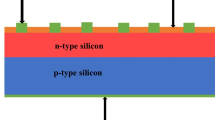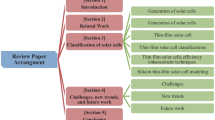Abstract
In this paper, we present a simulation study of Cu(In,Ga)Se2 (CIGS) based solar cell using a physically based two-dimensional device simulator Silvaco-Atlas under AM1.5 illumination. First, we studied the effect of CIGS layer thickness, doping concentrations, and defects on the J–V properties and the quantum efficiency (QE) of a conventional cell. The simulated structure shows an open circuit voltage equal to 0.80 V, a short circuit current density equal to 30.03 mA/cm2, a fill factor equal to 82.77% and the obtained efficiency of the conventional cell is 19.80% with CIGS absorber layer thickness of about 1.5 μm, our simulation results of the CIGS solar cell are in good agreement with the simulated and experimental results found in literature. In order to improve the solar cells efficiency, the back surface field (BSF) based on hydrogenated microcrystalline silicon μc-Si:H(p+) layer has been inserted between the back contact (Mo) and the CIGS absorber layer, in this case the structure presents an open voltage equal to 0.84 V, a short circuit current density equal to 32.55 mA/cm2, a fill factor equal to 85.31% and an efficiency of 23.42%. The obtained results demonstrate that the addition of μc-Si:H(p+) BSF layer increases the efficiency of CIGS solar cells, reaching a maximum value of 23.42% for 1.5 μm of CIGS thickness and 10 nm for μc-Si:H(p+) BSF layer.










Similar content being viewed by others
Data availability
Enquiries about data availability should be directed to the authors.
References
Guirdjebaye, N., Teyou Ngoupo, A., Ouedraogo, S., Mbopda Tcheum, G.L., Ndjakan, J.M.B.: Numerical analysis of CdS-CIGS interface configuration on the performances of Cu(In, Ga)Se2 solar cells. Chin. J. Phys. 67, 230–237 (2020). https://doi.org/10.1016/j.cjph.2020.02.033
Luque, A., Hegedus, S.: Photovoltaic Science and Engineering. https://doi.org/10.1002/0470014008.
Ghorbani, E., Kiss, J., Mirhosseini, H., Roma, G., Schmidt, M., Windeln, J., Kühne, T.D., Felser C, C.: Hybrid-functional calculations on the incorporation of Na and K impurities in to the CuInSe2 and CuIn5Se8 solar-cell materials. J. Phys. Chem. C 119(45), 25197–25203 (2015). https://doi.org/10.1021/acs.jpcc.5b07639
Biplab, S.R.I., Ali, M.H., Moon, M.M.A., Pervez, M.F., Rahman, M.F., Hossain, J.: Performance enhancement of CIGS-based solar cells by incorporating an ultrathin BaSi2 BSF layer. J. Comput. Electron. 19(1), 342–352 (2019). https://doi.org/10.1007/s10825-019-01433-0
Huang, C.H.: Effects of Ga content on Cu(In, Ga)Se2 solar cells studied by numerical modelling. J. Phys. Chem. Solids 69(2–3), 330–334 (2008). https://doi.org/10.1016/j.jpcs.2007.07.093
Wei, S.H., Zhang, S.B., Zunger, A.: Effects of Ga addition to CuInSe2 on its electronic, structural, and defect properties. Appl. Phys. Lett. 72(24), 3199–3201 (1998). https://doi.org/10.1063/1.121548
Gloeckler, M., Sites, J.R.: Band-gap grading in Cu (In, Ga) Se2 solar cells. J. Phys. Chem. Solids 66(11), 1891–1894 (2005). https://doi.org/10.1016/j.jpcs.2005.09.087
Friedlmeier, T.M., Jackson, P., Bauer, A., Hariskos, D., Kiowski, O., Wuerz, R., Powalla, M.: Improved photocurrent in Cu(In, Ga)Se2 solar cells: from 20.8% to 21.7% efficiency with Cds buffer. IEEE J. Photovolt. 5(5), 1487–1491 (2015). https://doi.org/10.1109/JPHOTOV.2015.2458039
Jackson, P., Wuerz, R., Hariskos, D., Lotter, E., Witte, W., Powalla, M.: Effects of heavy alkali elements in Cu (In, Ga) Se2 solar cells with efficiencies up to 22.6%. Phys. Status Solidi Rapid Res. Lett. 10(8), 583–586 (2016). https://doi.org/10.1002/pssr.201600199
Goffard, J., Colin, C., Mollica, F., Cattoni, A., Sauvan, C., Lalanne, P., Guillemoles, J.F., Naghavi, N., Collin, S.: Light trapping in ultrathin CIGS solar cells with nanostructured back mirrors. IEEE J. Photovolt. 7(5), 1433–1441 (2017). https://doi.org/10.1109/jphotov.2017.2726566
Ullal, H. S., Zwelbel, K., Von Roedern, B.: Current status of polycrystalline thin-film PV technologies. In: Conference Record of the Twenty Sixth IEEE Photovoltaic Specialists Conference-1997, pp. 301–305. IEEE. https://doi.org/10.1109/pvsc.1997.654089.
Yamaguchi, M.: Radiation resistance of compound semiconductor solar cells. J. Appl. Phys. 78(3), 1476–1480 (1995). https://doi.org/10.1063/1.360236
Afshari, H., Durant, B.K., Brown, C.R., Hossain, K., Poplavskyy, D., Rout, B., Sellers, I.R.: The role of metastability and concentration on the performance of CIGS solar cells under low-intensity-low-temperature conditions. Sol. Energy Mater. Sol. Cells 212, 110571 (2020). https://doi.org/10.1016/j.solmat.2020.110571
Ishizuka, S., Yamada, A., Fons, P., Niki, S.: Flexible Cu(In, Ga)Se2 solar cells fabricated using alkali-silicate glass thin layers as an alkali source material. J. Renew. Sustain. Energy 1(1), 013102 (2009). https://doi.org/10.1063/1.3005376
Chirilă, A., Buecheler, S., Pianezzi, F., Bloesch, P., Gretener, C., Uhl, A.R., Kranz, L., Perrenoud, J., Seyrling, S., Verma, S., Nishiwaki, S., Romanyuk, Y.E., Bilger, G., Tiwari, A.N.: Highly efficient Cu(In, Ga)Se2 solar cells grown on flexible polymer films. Nat. Mater. 10(11), 857–861 (2011). https://doi.org/10.1038/nmat3122
Kato, T.: Cu(In, Ga)(Se, S)2 solar cell research in solar frontier: progress and current status. Jpn. J. Appl. Phys. 56(4S), 04CA02 (2017). https://doi.org/10.7567/jjap.56.04ca02
Kazmerski, L.L., Hallerdt, M., Ireland, P.J., Mickelsen, R.A., Chen, W.S.: Optical properties and grain boundary effects in CuInSe2. J. Vac. Sci. Technol. A Vac. Surf. Films 1(2), 395–398 (1983). https://doi.org/10.1116/1.571928
Repins, I., Contreras, M., Romero, M., Yan, Y., Metzger, W., Li, J., Noufi, R.: Characterization of 19.9%-efficient CIGS absorbers. In: 2008 33rd IEEE Photovoltaic Specialists Conference, pp. 1–6. IEEE. https://doi.org/10.1109/pvsc.2008.4922628.
Chirilă, A., Reinhard, P., Pianezzi, F., Bloesch, P., Uhl, A.R., Fella, C., Kranz, L., Keller, D., Gretener, C., Hagendorfer, H., Jaeger, D., Erni, R., Nishiwaki, S., Buecheler, S.: Potassium-induced surface modification of Cu(In, Ga)Se2 thin films for high-efficiency solar cells. Nat. Mater. 12(12), 1107–1111 (2013). https://doi.org/10.1038/nmat3789
Kato, T., Wu, J., Hirai, Y., Sugimoto, H., Bermudez, V.: Record efficiency for thin-film polycrystalline solar cells up to 22.9% achieved by Cs-Treated Cu(In, Ga) (Se, S). IEEE J. Photovolt. 9(1), 325–330 (2018). https://doi.org/10.1109/jphotov.2018.2882206
Heriche, H., Rouabah, Z., Bouarissa, N.: New ultra thin CIGS structure solar cells using SCAPS simulation program. Int. J. Hyd. Energy 42(15), 9524–9532 (2017). https://doi.org/10.1016/j.ijhydene.2017.02.099
Benabbas, S., Rouabah, Z., Bouarissa, N., Chelali, N.: The role of back surface field SnS layer in improvement of efficiency of CdTe thin film solar cells. Optik Int. J. Light Electron Opt. 127(15), 6210–6217 (2016). https://doi.org/10.1016/j.ijleo.2016.04.050
Cherouana, A., Labbani, R.: Numerical simulation of CZTS solar cell with silicon back surface field. Mater. Today Proc. 5(5), 13795–13799 (2018). https://doi.org/10.1016/j.matpr.2018.02.020
Kim, S., Dao, V.A., Shin, C., Balaji, N., Yi, J.: Influence of n-Doped μc-Si: H back surface field layer with micro growth in Crystalline-amorphous silicon heterojunction solar cells. J. Nanosci. Nanotechnol. 14(12), 9258–9262 (2014). https://doi.org/10.1166/jnn.2014.10123
Rawat, A., Sharma, M., Chaudhary, D., Sudhakar, S., Kumar, S.: Numerical simulations for high efficiency HIT solar cells using microcrystalline silicon as emitter and back surface field (BSF) layers. Sol. Energy 110, 691–703 (2014). https://doi.org/10.1016/j.solener.2014.10.004
Ouédraogo, S., Zougmoré, F., Ndjaka, J.M.B.: Computational analysis of the effect of the surface defect layer (SDL) properties on Cu(In, Ga)Se2-based solar cell performances. J. Phys. Chem. Solids 75(5), 688–695 (2014). https://doi.org/10.1016/j.jpcs.2014.01.010
Pudov, A.O., Kanevce, A., Al-Thani, H.A., Sites, J.R., Hasoon, F.S.: Secondary barriers in CdS–Cu(In1−x Gax)Se2 solar cells. J. Appl. Phys. 97(6), 064901 (2005). https://doi.org/10.1063/1.1850604
Bouabdelli, M.W., Rogti, F., Maache, M., Rabehi, A.: Performance enhancement of CIGS thin-film solar cell. Optik 216, 164948 (2020). https://doi.org/10.1016/j.ijleo.2020.164948
Wagner, S., Shay, J.L., Migliorato, P., Kasper, H.M.: CuInSe2/CdS heterojunction photovoltaic detectors. Appl. Phys. Lett. 25(8), 434–435 (1974). https://doi.org/10.1063/1.1655537
Software, D. S. Atlas User's Manual. 567–1000 (2016).
Elbar, M., Tobbeche, S.: Numerical simulation of CGS/CIGS single and tandem thin-film solar cells using the silvaco-atlas software. Energy Proc. 74, 1220–1227 (2015). https://doi.org/10.1016/j.egypro.2015.07.766
Gloeckler, M., Sites, J.R., Metzger, W.K.: Grain-boundary recombination in Cu(In, Ga)Se2 solar cells. J. Appl. Phys. 98(11), 113704 (2005). https://doi.org/10.1063/1.2133906
Mutch, M.J., Pomorski, T., Bittel, B.C., Cochrane, C.J., Lenahan, P.M., Liu, X., Nemanich, R., Brockman, J., French, M., Kuhn, M., French, B., King, S.W.: Band diagram for low-k/Cu interconnects: the starting point for understanding back-end-of-line (BEOL) electrical reliability. Microelectron. Reliab. 63, 201–213 (2016). https://doi.org/10.1016/j.microrel.2016.04.004
Chelvanathan, P., Hossain, M.I., Amin, N.: Performance analysis of copper–indium–gallium–diselenide (CIGS) solar cells with various buffer layers by SCAPS. Curr. Appl. Phys. 10(3), 387–391 (2010). https://doi.org/10.1016/j.cap.2010.02.018
Benmir, A., Aida, M.S.: Analytical modeling and simulation of CIGS solar cells. Energy Proc. 36, 618–627 (2013). https://doi.org/10.1016/j.egypro.2013.07.071
Heriche, H., Rouabah, Z., Bouarissa, N.: High-efficiency CIGS solar cells with optimization of layers thickness and doping. Optik Int. J. Light Electron Opt 127(24), 11751–11757 (2016). https://doi.org/10.1016/j.ijleo.2016.09.071
Boudour, S., Bouchama, I., Bouarissa, N., Hadjab, M.: A study of CdTe solar cells using Ga-doped MgxZn1-xO buffer/TCO layers: simulation and performance analysis. J. Sci. Adv. Mater. Dev. 4(1), 111–115 (2019). https://doi.org/10.1016/j.jsamd.2018.12.001
Rougieux, F.E., Sun, C., Macdonald, D.: Determining the charge states and capture mechanisms of defects in silicon through accurate recombination analyses: a review. Sol. Energy Mater. Sol. Cells 187, 263–272 (2018). https://doi.org/10.1016/j.solmat.2018.07.029
Amin, N., Sopian, K., Konagai, M.: Numerical modeling of CdS/CdTe and CdS/CdTe/ZnTe solar cells as a function of CdTe thickness. Sol. Energy Mater. Sol. Cells 91(13), 1202–1208 (2007). https://doi.org/10.1016/j.solmat.2007.04.006
Tanaka, K., Oonuki, M., Moritake, N., Uchiki, H.: Cu2ZnSnS4Cu2ZnSnS4 thin film solar cells prepared by non-vacuum processing. Sol. Energy Mater. Sol. Cells 93(5), 583–587 (2009). https://doi.org/10.1016/j.solmat.2008.12.009
Jimbo, K., Kimura, R., Kamimura, T., Yamada, S., Maw, W.S., Araki, H., Katagiri, H.: Cu2ZnSnS4-type thin film solar cells using abundant materials. Thin Solid Films 515(15), 5997–5999 (2007). https://doi.org/10.1016/j.tsf.2006.12.103
Ghorbani, T., Zahedifar, M., Moradi, M., Ghanbari, E.: Influence of affinity band gap and ambient temperature on the efficiency of CIGS solar cells. Optik 223, 165541 (2020). https://doi.org/10.1016/j.ijleo.2020.165541
Ramanathan, K., Contreras, M.A., Perkins, C.L., Asher, S., Hasoon, F.S., Keane, J., Young, D., Romero, M., Metzger, W., Noufi, R., Ward, J., Duda, A.: Properties of 19.2% efficiency ZnO/CdS/CuInGaSe2 thin-film solar cells. Prog. Photovolt. Res. Appl. 5, 4 (2003). https://doi.org/10.1002/pip.494
Yang, X., Chen, B., Chen, J., Zhang, Y., Liu, W., Sun, Y.: ZnS thin film functionalized as back surface field in Si solar cells. Mater. Sci. Semicond. Process. (2018). https://doi.org/10.1016/j.mssp.2017.08.011
Kohara, N., Nishiwaki, S., Hashimoto, Y., Negami, T., Wada, T.: Electrical properties of the Cu(In, Ga)Se2/MoSe2 /Mo structure. Sol. Energy Mater. Sol. Cells (2001). https://doi.org/10.1016/S0927-0248(00)00283-X
Fathi, M., Abderrezek, M., Djahli, F., Ayad, M.: Study of thin film solar cells in high temperature condition. Energy Proc. 74, 1410–1417 (2015). https://doi.org/10.1016/j.egypro.2015.07.788
Funding
This work did not receive any specific give from funding agencies in the public, not for profit sectors, or commercial.
Author information
Authors and Affiliations
Contributions
RZ: Writing—original draft, Validation, Formal analysis, Software, Writing—review & editing, Resources. IB: Investigation, Supervision, Visualization, Writing—original draft, Software. OS: Formal analysis, Software, Validation, Writing—review & editing. LD: Writing—original draft, Writing—review & editing. EZ: Writing—original draft.
Corresponding author
Ethics declarations
Conflict of interest
The authors announced that there is no conflict of interests regarding the publication of this article.
Additional information
Publisher's Note
Springer Nature remains neutral with regard to jurisdictional claims in published maps and institutional affiliations.
Rights and permissions
Springer Nature or its licensor holds exclusive rights to this article under a publishing agreement with the author(s) or other rightsholder(s); author self-archiving of the accepted manuscript version of this article is solely governed by the terms of such publishing agreement and applicable law.
About this article
Cite this article
Zouache, R., Bouchama, I., Saidani, O. et al. Numerical study of high-efficiency CIGS solar cells by inserting a BSF µc-Si:H layer. J Comput Electron 21, 1386–1395 (2022). https://doi.org/10.1007/s10825-022-01942-5
Received:
Accepted:
Published:
Issue Date:
DOI: https://doi.org/10.1007/s10825-022-01942-5




